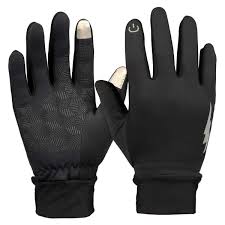One person’s definition of a glove is not another person’s definition of glove. You can tell a lot about a person by looking at their gloves. Is that an American glove or Canadian glove? Is that a touch sensitive glove? Wait, what? That’s not even funny. Yep, these are the ones with the little pad on the tip of the pointer finger.
A report from PortNews24 suggests that the market for these types of gloves is growing rapidly. Why? Global warming? Are cellphones just now making it into Canada, Sweden, Norway, Finland and Siberia?
Other articles report it is simply that fact that touch screens are being incorporated into even more areas of daily life and running into situations where people often wear gloves. In many of these situations, the gloves that people normally use do not work well with the touch screen. OK. Simple enough answer for why the increase in touch sensitive gloves, but you will notice a nuance in the answer; the gloves are blamed for not working rather than the touch screen. It seems to me that the touch screen should be responsible for working with whatever gloves might be present. Progress is being made and many touch controller manufacturers list “glove use”, but like a good political tag-line, there are many underlying details that must be considered.
The biggest detail: what type of glove is required? Fine Italian leather driving gloves, snowmobiling gloves, hockey gloves, gardening gloves? Or, the cotton ones with odd rubber fingers sold by my friend Jim on Amazon?
Medical devices are just now starting to incorporate touch screens as part of their HMI (human machine interface). It is common practice that nitrile gloves or similar are worn by the person using the machine. Part of the design process includes specifying exactly what type of glove is expected to be used in the application. It is imperative that glove or the worse-case-situation glove be used when tuning the touch system.
Touch controllers will list a multitude of features for their controller: water resistance, thick-glass touch, and glove use. Each ‘feature’ must be specified in detail. More importantly, designing around one requirement very often negatively impacts another. For example, designing a system for water immunity can make the screen feel less responsive to suppress false touches caused by the water. To enable the use of thicker gloves, the sensitivity needs to be increased. Putting both these requirements into the same application requires extensive testing be performed against a well written specification. And understanding that both requirements may not be met.
Alsentis developed some technology that allows the use of PCAP to be extended beyond what many considered possible. Their video page shows parts working through ½” glass with a glove while being sprayed with water. Pretty cool stuff. It should be noted that the Alsentis controller is designed for discrete touch point applications. It also highlights a great opportunity to use a custom touch screen assembly rather than a one-size-fits-all, standard option touch screen solution. In many industrial and medical applications, a discrete touch point design can provide the best end user experience which, ultimately, is what we all want.
The touch screen should work exactly as it is supposed to, in its intended end-use environment, gloves are no exception.
Have a design question? Don’t hesitate to ask, our expert design engineers are here for you! (no obligations, I promise)
